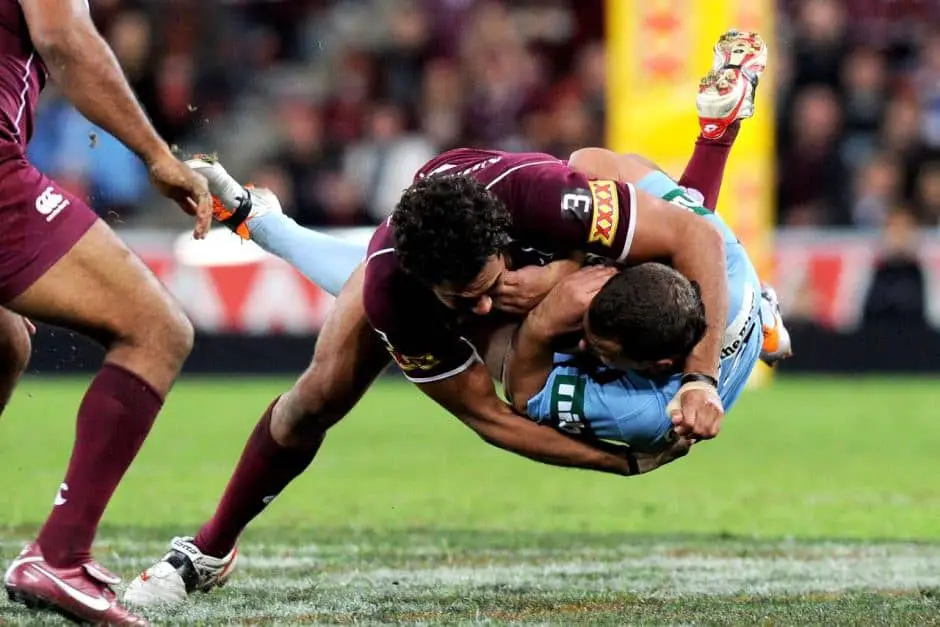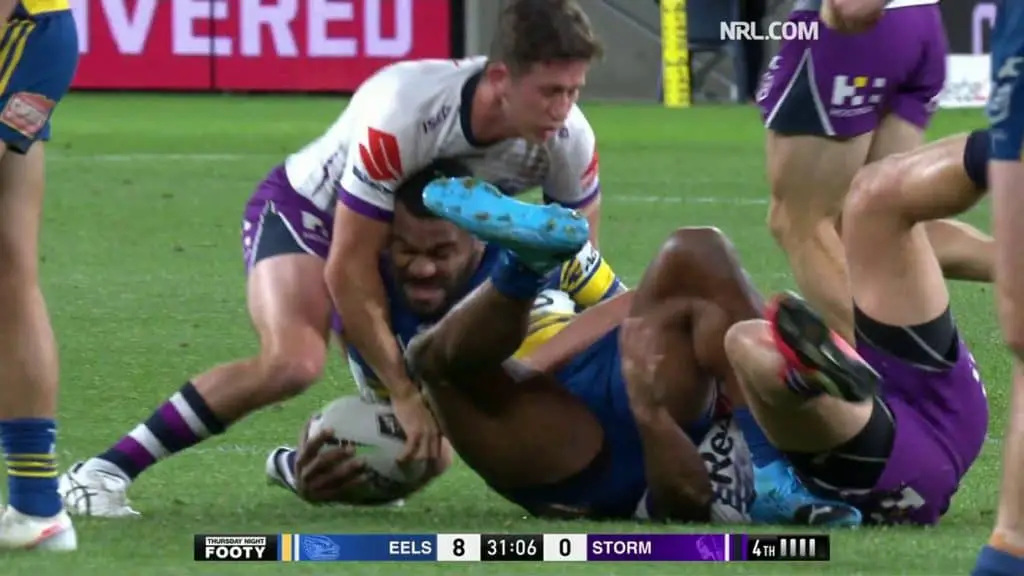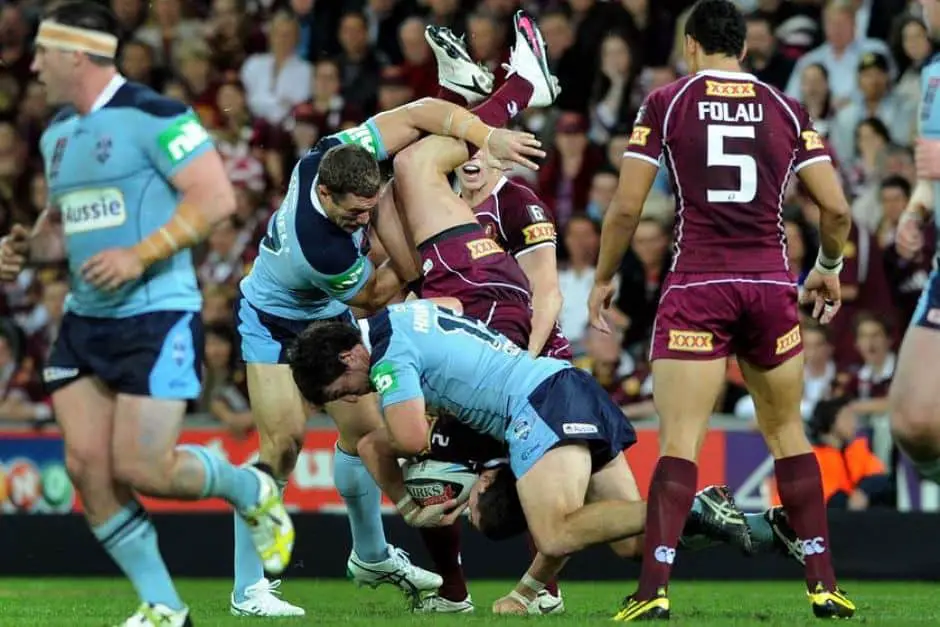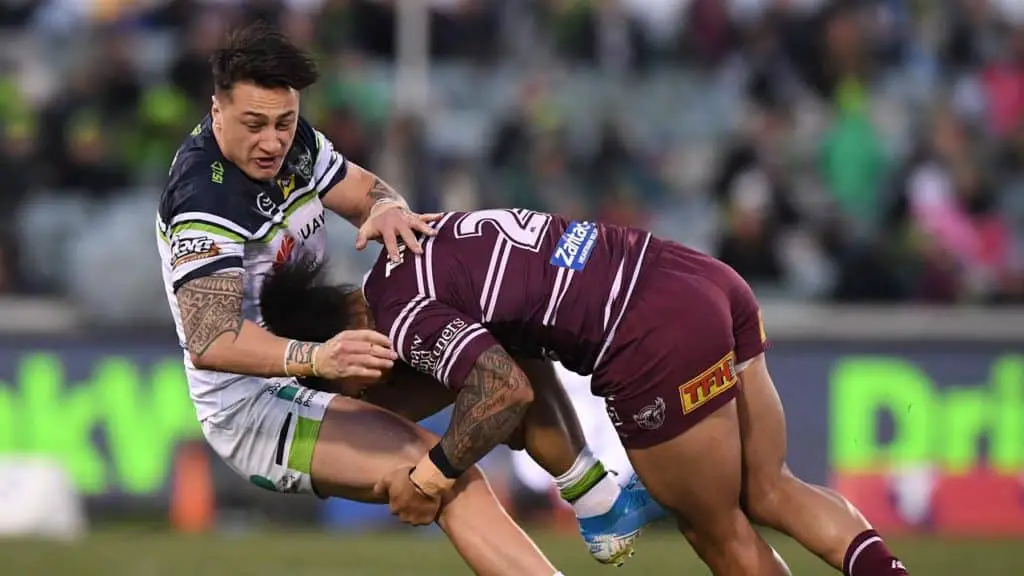
If you are just a casual observer or a beginner rugby league player you could be forgiven to think there is no method to the madness of a tackle. From the outside it just looks like huge men running into each other and sometimes they fall over and sometimes they don’t. However, tackling is actually a bit of science which we will explore in this article.
How do you tackle in rugby league?
To execute the perfect tackle in rugby league you need to take a staggered stance with one foot in front of the other. Get your lead as close to your opposition as possible. Lower your body height and load your quads. Push off your back foot, drive your shoulder anywhere between your opponent’s thighs and lower ribs with your head outside their body. As you make contact wrap your arms around their legs and drive them to the opposite side you have your head placed in a diagonal direction.
The aforementioned description on how to perform the perfect tackle may sound pretty simple but it is a different story when a 100kg brute is sprinting at you and you are forced to rely on your instincts. It takes many years to master the art of tackling so don’t worry if you feel like you currently couldn’t tackle your grandmother. After hundreds of hours of drilling you will turn yourself into a tackling monster.
What Is A High Tackle In Rugby League?

A high tackle in rugby league is a tackle that makes contact above the shoulders of the attacking player. High tackles are illegal and result in penalties as they can cause concussions and facial injuries.
Contrary to popular belief there are rules surrounding tackling. You can’t even though I’m sure many players would like to just remove your opposition’s head by launching your shoulder into their face. This is what is known as a high or head high tackle in rugby league.
In the past high tackles were often tolerated in the rugby league and were viewed as just part of the game. If a player even thought of complaining about taking a whack to the face or neck they would be chastised for being a wimp.
Today is a totally different era. If a player even cops minimal contact above the shoulder line he will dramatically appeal to the referee in hopes of winning a penalty. Even though high tackles are still quite common they have been explicitly banned in rugby league and the majority of the offenders are caught and penalised.
What Is A Crusher Tackle?

A crusher tackle is where the back of a player’s neck is forcibly driven down so his chin touches his chest under the weight of the tackling player. This form of tackling is illegal as it can lead to neck injuries.
Crusher tackles became popular in the rugby league after attacking players would and spin after making contact and then continue driving in the tackle with their back faced towards the defending side. To make attacking players think twice before utilising this effective metre gaining method tacklers would place all of their weight on the back of the attacker’s neck causing their necks to violently compress leading to severe pain and neck injuries.
Rugby league officials quickly noticed the new trend of crusher tackles and quickly outlawed them. Now if a player is found guilty of a crusher tackle they will face an automatic one game suspension.
The suspension may seem harsh, however you have to factor in how sensitive the neck is and the potential for serious injury caused by this completely unnecessary tackling style. Fortunately, rugby league officials clamped down crusher tackles before a player suffered a permanent neck injury such as paralysis.
Can You Shoulder Charge In Rugby League?
The shoulder charge was banned in rugby league in 2012. Prior to 2012 the shoulder charge was a common method of tackling. Sonny Bill Williams was particularly famous for his devastating shoulder charge when he played for Bulldogs.
The shoulder charge was banned because rugby league officials felt that players did not have enough control over the tackle. This lack of control led to regular contact between the tackler’s shoulder and the attacker’s head. Officials also noted that shoulder charge collisions were much higher impact then regular tackles as the tackler would launch themselves into the barge. This led to many high impact and devastating concussions.
This was occurring under the backdrop of the CTE revelations of American footballers so it is no wonder that the top brass at the NRL wanted to protect its players and their brains.
A young Sonny Bill Williams who burst onto the scene in the mid 2000s was not only making a mark on the game with his fancy ball play and his explosiveness. The New Zealander also had many of his opposition terrified of his signature shoulder charge that had left more than one big man having second thoughts about taking the next hit up if Williams was in the vicinity.
Here Is Sonny Bill Willams Introducing Joel Clinton To His Left Shoulder In 2004
Why Do Rugby League Players Tackle High?
Rugby league players tackle high to prevent offloads by wrapping up the attacker’s arms and the ball. They also tackle high to allow them to wrestle the attacking player to their back to slow down the play the ball.
Rugby league and union players often utilise different tackling techniques. Union players will often tackle one on one and also typically much lower than their league cousins. In rugby league it is common for 2 or 3 players to be involved in every tackle with one tackling the upper body and the other dealing with the legs.
The high upper body style of tackling is so popular in rugby league because it diffuses the threat of offloads. Offloads are a spark that lead to many line breaks and tries. By tackling high and securing the upper body of the attacking player they can not effectively offload the ball to their teammates, shutting down an effective offensive maneuver.
Rugby league players will often tackle high because it allows them to turn their opponents to their back. It is difficult to pin an opponent to his back if you only have control of his legs. It becomes much easier if you control his upper shoulder region. The reason league players want to force attacker’s to their backs is because it slows down the ruck which gives the defending side an extra precious seconds to establish their defensive line and plug any holes that could be sniffed out by the attackers.
What Is A Spear Tackle In Rugby League?

A spear tackle is where you lift a rugby league player past horizontal before driving them to the ground. You can lift in a tackle but you must not drop the player on their head or lift them past horizontal otherwise it is a penalty as this is viewed to be a spear tackle.
Why Is The Spear Tackle In NRL Very Dangerous?
The spear tackle in NRL is very dangerous as it can easily lead to players suffering concussions and neck injuries as their heads are driven into the ground with a large amount of force. The head and neck are sensitive areas of the body and are susceptible to permanent catastrophic injuries.
If you want evidence of the danger of a spear tackle then look no further than Alex Mckinnon. In 2014, the Newcastle Knights second rower was lifted in a spear tackle and had his driven into the ground. Mckinnon broke his C4 and C5 vertebrae and is now permanently paralysed. The risk of serious injury from spear tackles is great and they need to be severely punished to ensure other players don’t suffer the same fate as Mckinnon.
I think the NRL should ban all blatant lifting in tackles whether or not the player is lifted past horizontal. Lifting tackles don’t happen very frequently in games so it would have zero impact on the sport. By banning them completely though it would further prevent spear tackles as there is no blurred line between a legal and non legal lifting tackle.
If lifting tackles were banned Mckinnon would not have suffered his injury because as soon as he was lifted off the ground the referee would have stopped the play and penalised the offending side. There would have been no opportunity for the tacklers to spike his head into the pitch.
Conclusion

From the outside there doesn’t appear to be much technique involved in rugby league tackling. However, once you take a bit of a closer look you will see players are using specific techniques to ensure they bring down their hulking opposition. Not only is rugby tackling highly technical but there are also strict rules ensuring that it is done safely.
